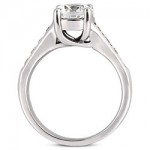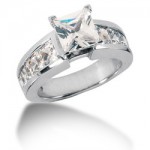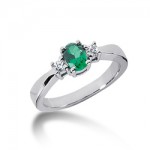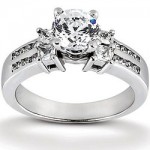The perfect engagement ring is more than just a diamond on a band – it’s a symbol of the love that you and your sweetie will share for the rest of your lives together. It’s a declaration to the world that you have finally found “The One” that you’re ready to share your world with. It’s also a wonderful way of showing off just how unique and special the relationship is between you and your future spouse!
Whether you’re looking for a unique engagement ring or inexpensive engagement rings, you’ll need to do a fair amount of research before you head to your nearest jeweler. After all, it’s not just the design of diamond itself that you’ll need to consider: you also need to investigate which engagement ring setting is just right for your sweetheart.
If you don’t know the difference between a prong setting and a tension setting – and every other setting in between – there’s no need to worry. Get ready to learn about the wonderful world of engagement ring settings!
What Is An Engagement Ring Setting?
Simply put, an engagement ring setting is the mounting which attaches the gemstone to the ring’s band. In this light, considering the right engagement ring setting isn’t just a question of style and taste – a great setting will also ensure that your sweetie’s precious gemstone doesn’t detached from the band.
Different engagement ring settings can lend an air of sophistication and elegance to a ring, or it can make a funky and unique statement; no matter what setting you choose, make sure that it reflects the tastes of your bride-to-be. The perfect engagement ring is something that she’s been dreaming about every since she was a little girl – and you want to make sure that you get it right when you finally go down on one knee!
Now that you know what an engagement ring setting is, let’s examine the different styles of settings that won’t just make an impact when you propose – they’ll commemorate the day that you and your love decided to share the rest of your lives together.
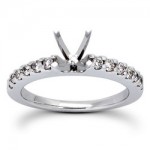 Prong Setting As one of the world’s most popular styles for engagement ring settings, the prong set engagement rings are featured in gorgeous and unique designs like the solitaire ring. Designed in 1886, the prong setting features what appears to be metal “claws” (otherwise known as the prong), which creates a basket shape where the gemstone sits. Four and six-prong styles are among the most popular choices for this particular setting, as it provides a firm yet symmetrical setting that allows for maximum light to shine through the diamond. Additionally, prongs can be flat, pointed or V-shaped; the shape you’ll choose depends on the cut of the gemstone. Ideally, heart and pear-shaped stones look best with V-shaped prongs, while emerald-cut stones stand out with flat prongs. While the prong setting style is ideal for larger diamonds, it’s not suited for smaller gemstones, as the prongs can appear to overwhelm delicate gemstones. |
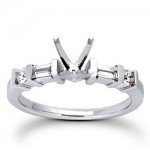 The bar setting functions like the prong setting, except the prongs are fused into thin metal bars which run vertically between the gemstones. This keeps the stones firmly in place while also showcasing the appearance of the ring’s metal. It’s a contemporary spin on a classic look; however, the unevenness of the design can cause discomfort to the wearer, especially if she’ll wear her ring every day. |
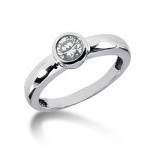 Bezel Setting A bezel setting on an engagement ring can not only keep your gemstone securely in place – the setting can also make smaller diamonds appear larger and intensify the look of colored gemstones! A metal band wraps around the perimeter of the circular gemstone, which protects the stone from receiving nicks or chips from everyday wear. If you’re decided on a bezel set engagement ring, then choosing the right type of metal can make a big impact on the brilliance of the stone. For example, a white metal surrounding a white or clear stone can make it appear much larger (perfect for those on a budget!), while a yellow metal setting can bring out the colors from a red or green gemstone. However, don’t choose a yellow metal for a white stone, as this will actually work to make the gemstone appear smaller. |
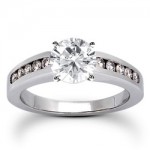 Channel Setting Channel settings have always been a popular choice for unique wedding bands, but now this style has been picked up by sleek and contemporary engagement rings. The channel setting – perfect for those engagement rings which have multiple stones – features a row of beautiful gemstones, which aren’t separated by any metals bands or prongs. This channel can extend on part or all around the ring, and is perfect for the woman who wants to wear her engagement ring on special occasions. While the channel setting provides more of a secure hold on gemstones and has a smooth surface, high-quality engagement rings featuring a channel setting can be extremely difficult to resize. Therefore, make sure you know your sweetie’s ring size before you venture into online diamond shopping! |
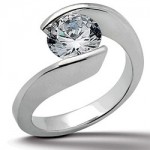 Tension Setting As a newly popular choice for engagement rings, the tension setting gives the diamond the appearance of “floating” between the metal band. However, the gemstone isn’t floating at all; rather, it’s compressed between the metal band to keep it firmly in place. The tension setting is perfect for hard stones like diamonds, sapphires and rubies, as they’re the only gemstones which can withstand the large amount of pressure that’s required to keep the stone in place. Additionally, the tension setting allows plenty of light to hit the stone and maximize the brilliance. Smaller and larger diamonds can be used within the tension ring; however, the tension ring setting isn’t ideal for extremely small or large diamonds, as the size will then clash with the wedding band. If you’re thinking of getting a tension engagement ring for your sweetie, note that repair and maintenance is quite difficult due to the design of the setting, and can often only be done by the manufacturer. |
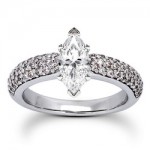 Pave Setting Pronounced “pah-vay”, the pave setting is a French-inspired design which features three or more rows of small stones fitted into holes that then place the gemstones at level with the surface of the ring’s band. The surrounding metal is raised to form tiny beads that are not only pleasing to the eye – they serve to keep the stones securely in place. The pave setting can give the illusion that the gemstones are much bigger than what they actually are, although the beads can provide a less secure setting than a prong or tension setting. Therefore, only smaller diamonds should be used with this type of engagement ring setting. Pave set rings are also more expensive than other engagement rings due to the number of stones needed; however, the impact that this gorgeous and elegant setting makes on the special day is more than worth it! |

